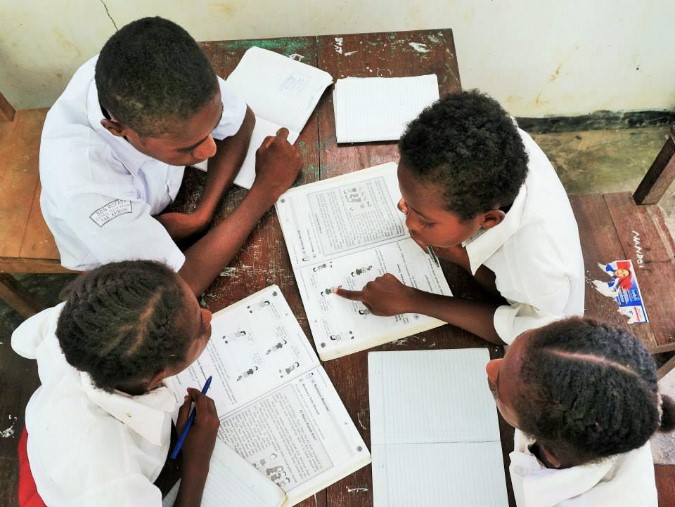Seiring dengan sosialisasi kegiatan KIAT Guru di Kabupaten Kaimana, Papua Barat, tim dari TNP2K juga mengunjungi dua desa yang terletak di kabupaten tersebut. Agenda kunjungan mencakup uji coba tes penilaian hasil belajar siswa, yang digunakan untuk mengukur kemampuan membaca dalam Bahasa Indonesia dan kompetensi matematika.
Salah satu tujuan instrumen ini adalah mengukur keterkaitan antara keberadaan dan kualitas pelayanan guru dengan kompetensi belajar siswa. Sebuah tes sederhana dikembangkan untuk mendeteksi kemampuan dasar membaca dan matematika yang setara dengan tingkat kompetensi kelas 1 dan kelas 2 dalam Kurikulum Nasional 2006 (KTSP 2006). Dalam tes membaca, kemampuan murid dinilai untuk membaca huruf, kata, paragraf pendek, dan cerita pendek. Dalam tes matematika, kemampuan murid didiagnosa untuk mengenal angka 0-9, 10-20, pengurangan, serta pembagian.

Siswa-siswi SD YPK Sawatawera di Kabupaten Kaimana saat belajar membaca buku teks sekolah
Tes diberikan kepada murid sekolah dasar di dua desa yang dikunjungi. Setiap murid dinilai secara individual. Hal ini memungkinkan pengamatan yang lebih komprehensif untuk melihat tantangan khusus dan kemajuan belajar yang dimiliki masing-masing siswa dalam kedua bidang tersebut. Hasil dari penilaian ini menunjukkan kompetensi siswa sampel dari desa-desa ini masih berada di bawah rata-rata. Bahkan siswa yang duduk di kelas 4 sampai 6 misalnya, masing mengalami kesulitan untuk membaca dan memahami suatu bagian cerita pendek (yang terdiri dari 7 paragraf dan kurang dari 50 kata). Padahal, kompetensi ini, menurut KTSP 2006, seharusnya diajarkan dan sudah dikuasai oleh murid pada akhir kelas 2.
Temuan di Kaimana sangat bertolak belakang dengan hasil yang dicapai dalam pra-pengujian yang sama yang dilakukan terhadap sampel dari murid sekolah dasar di daerah perkampungan Jakarta, di mana mayoritas siswa kelas 3 hingga 6 siswa mampu membaca dan memahami cerita pendek yang sama dengan baik dan benar.
Kompetensi siswa dalam matematika ternyata tidak menunjukkan hasil yang lebih baik. Mayoritas siswa yang diuji, dari semua tingkatan kelas, masih mengalami kesulitan dalam soal-soal pengurangan dan penjumlahan, terutama yang melibatkan peminjaman. Kompetensi ini juga seharusnya merupakan kemampuan yang seharusnya dikuasai oleh siswa di akhir kelas 2.
Sebuah pengalaman yang memilukan muncul ketika tim duduk bersama seorang anak perempuan yang masih berusia tujuh tahun dan sedang duduk di bangku kelas 1 SD. Saat ia diberikan tes tentang membaca huruf, ia hanya melihat kertas soal dengan tatapan kosong. Ia berusaha keras untuk membaca setiap huruf di sana. Ia menjadi semakin sulit membaca ketika diberikan soal-soal membaca angka. Ternyata, ia masih tak bisa membedakan angka dengan huruf. Berkali-kali ia terus menyebutkan bunyi-bunyi huruf yang baru saja dibaca olehnya, meskipun yang berada di hadapannya dan harus dibacanya adalah angka.
Meskipun hanya berdasarkan sampel murid yang sedikit, temuan-temuan ini menggambarkan ketertinggalan di kedua desa ini yang disebabkan oleh layanan pendidikan di sekolahnya. Karenanya, penelitian KIAT Guru diharapkan dapat mendorong motivasi para pemberi layanan—dalam hal ini, guru—dan komunitas untuk berkolaborasi untuk mendorong kehadiran guru dan kualitas pengajaran mereka.
✭ ✯ ✰ ✱ ✲ ✳ ❃ ❂ ❁